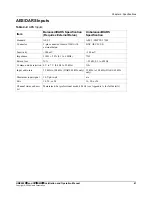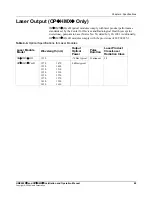
80
HMX6803
+
and OP
+
HMX
+
Installation and Operation Manual
Copyright © 2009, Harris Corporation
Appendix A: Laser Safety Guidelines
Laser Safety
Optical fiber telecommunication systems use semiconductor laser transmitters
that emit infrared light that is normally not visible to the human eye. Although a
conventional laser produces a small beam of light, the power density is very
high, and it can cause damage to your eyes.
If a beam of laser light enters the eye, the eye magnifies and focuses the energy
on the retina. The energy that reaches the retina can be as much as 100,000
times more than at the cornea and, as a result, it can burn the retina.
Laser transmission products are classified in four major groups (Class 1, 2, 3,
and 4), according to their emissions and potential for causing injury. Fiber optic
transmitter modules in this series are designated Class 1.
Precautions for Enclosed Systems
In its normal operating mode, an optical fiber communication system is totally
enclosed and presents no risk of eye injury. However, if the fiber optic cables
that interconnect various components of an optical fiber disconnect or break,
you may be exposed to laser emissions. Also, technicians may be exposed to
laser emissions during installation and servicing.
Unlike some other laser designs, semiconductor lasers have a highly divergent
beam that decreases rapidly with distance. The greater the distance, the less
energy will enter the eye, and the less potential risk for eye injury.
Under normal operating conditions, optical fiber telecommunication systems
are completely enclosed; nonetheless, observe the following precautions:
1. Do not stare into optical connectors or broken fibers.
2. Ensure technicians have satisfactorily completed an approved training
course before performing installation or maintenance.
3. Ensure there are appropriate warning labels near the optical ports of the
modules.
WARNING
Use of controls, adjustments, and procedures other than
those specified in this document may result in hazardous
laser radiation exposure.
WARNING
Eye damage may occur if an optical instrument such as a
microscope, magnifying glass, or eye loupe is used to stare
at the energized fiber end.
Summary of Contents for HMX6803+
Page 2: ......













































